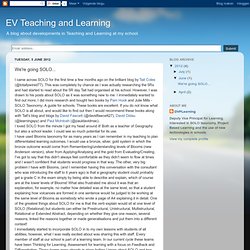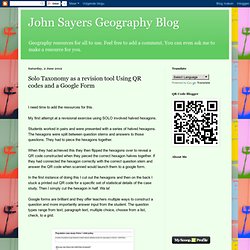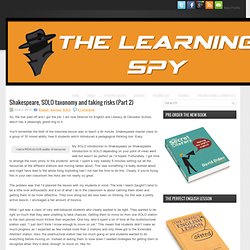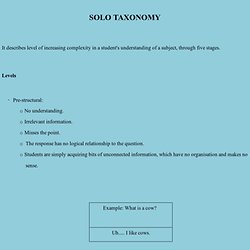

EV Teaching and Learning: We're going SOLO... I came across SOLO for the first time a few months ago on the brilliant blog by Tait Coles (@totallywired77).

This was completely by chance as I was actually researching the 5Rs and had started to read about the 5R day Tait had organised at his school. PE Revision Using Solo Taxonomy. John Sayers Geography Blog: Solo Taxonomy as a revision tool Using QR codes and a Google Form. I need time to add the resources for this.My first attempt at a revisional exercise using SOLO involved halved hexagons.Students worked in pairs and were presented with a series of halved hexagons.

The hexagons were split between question stems and answers to those questions. They had to piece the hexagons together. When they had achieved this they then flipped the hexagons over to reveal a QR code constructed when they pieced the correct hexagon halves together. Sharing SOLO with students. One of the questions that I have been asked a lot lately from either colleagues or Tweachers is 'How do you actually introduce SOLO taxonomy to students?

' Many of the people I chat to obviously have caught the bug and want to take it further in their lessons but had the same cautious questions that I did to begin with. Once you get your own head around SOLO, the terminology, symbols, resources and activities all make perfect sense. But it's getting your head around it that's the worry, and even more so for students. My Learning Journey.
Why I think SOLO taxonomy will help my Year 13s. Now, readers, I am assuming you have heard of SOLO taxonomy.

If you haven’t, I recommend you check out this website from Pam Hook, or this blog from David Didau, or this blog from Tait Coles. When you’ve done that come back again. My first PE SOLO experiments… « Was I Better Today Than Yesterday? After reading David Didau’s The Perfect Ofsted English Lesson and scouring the world wide web for teachers using SOLO, including Tait Coles, David Fawcett and Darren Mead to name but a few, I have finally started experimenting with utilising SOLO taxonomy in my GCSE, BTEC and A level PE classes.

The next few paragraphs will just explain, step by step, the process so far… Step 1 I introduced the 5 levels of understanding and the language and verbs associated with each through a Tait Coles poster with supporting information from Pam Hook and Julie Mills’s great introductory SOLO book. Essentially, I explained that SOLO provides the students and the teacher with a ‘common language of learning’ so both understand the quality of learning that students are producing. A great starting point can be found by watching David Didu’s explanation at a TeachMeet Clevedon earlier this year which can be found here: The need for ‘Why To’ guides. The need for 'Why To' guides I’m not a fan of telling people how to do things.

OK, that may not strictly speaking be true, but I do believe that just explaining how to solve a problem is unlikely to result in much learning. The best way is to learn is to think about why a problem should be solved. As teachers we often bemoan the fact that we’re not treated with respect as a profession. There are probably all sorts of reasons for this but one reason is the extent to which we’ve allowed ourselves to be told how we should teach. Shakespeare, SOLO taxonomy and taking risks (Part 2) So, the risk paid off and I got the job.

I am now Director for English and Literacy at Clevedon School, which has a pleasingly grand ring to it. You’ll remember the brief of the interview lesson was to teach a 40 minute Shakespeare master class to a group of 30 mixed ability Year 8 students which introduced a pedagogical thinking tool. Easy. Shakespeare, SOLO taxonomy and taking risks (Part 1) I have an interview on Monday.

For me the most stressful part of interview preparation is getting the lesson right. I’m happy to take criticism over almost anything else but I really don’t want to hear that my teaching is anything less than outstanding. Why? Because it’s what I do all day. If I can’t put together an outstanding lesson at an interview then, frankly, what’s the point? But, as we all know, interview lessons are highly artificial. The brief for the lesson I’m teaching on Monday is as follows: A 40 minute Shakespeare masterclass to a mixed ability Year 8 class of around 30 students in which a pedagogical thinking tool is introduced. My starting point for this was Lisa Jane Ashes’ blog post on using Shakespeare to introduce SOLO. But, fortune favours the bold. But, as soon as they’ve been briefed on SOLO stations protocol, they’re on their own.
Prestructural. Lesson 2 SOLO and Revision of Presentational Features. Feel free to be inspired by my retrospective forward thinking. Going SOLO! (Part 1) « Reflective Teacher and Learner. For some time now I have been unhappy with how I assess the progress of my pupils in lessons.

I have tried and tested various techniques including level ladders (KS3), ‘traffic lighting’ and have for a long time grappled with Bloom’s Taxonomy. Bloom’s in particular was enthusiastically pushed in the schools I have worked in since I started teaching 5 years ago. As much as I persevered with Bloom’s I found it incredibly clumsy and unwieldy. Admittedly, many of these issues may have been due to my lack of concrete understanding of the thinking behind the taxonomy. My biggest issue however, was the fact that the language of Bloom’s was not one that my pupils and I could easily converse in! After the umpteenth observation in my current workplace in which it was remarked that my formative assessment was ‘Good’ but not ‘Outstanding’, I turned to Twitter for help.
SoloTaxonomy.pdf. SOLO taxonomy. It describes level of increasing complexity in a student's understanding of a subject, through five stages.

Levels · Pre-structural: o No understanding. o Irrelevant information. o Misses the point. o The response has no logical relationship to the question. o Students are simply acquiring bits of unconnected information, which have no organisation and makes no sense. Integrating SOLO taxonomy and MyPortfolio. Because the ownership of MyPortfolio belongs to the student it is the perfect vehicle for encouraging the principles of Learning to Learn. An ePortfolio should consist of more than snapshots of learning through time but be a place where a student can clarify their learning, co-construct learning with their teachers support, reflect on their learning and scaffold their learning towards higher achievement in the future. This page aims to find a few examples of SOLO integration to allow teachers to see the context of its' use within the classroom setting. Solo taxonomy and Connectives. My comrade in SOLO @clarky099 a little while back started to compile connectives that would encourage students to think at the next level.
I have two lessons coming up, one of which is perfect for training the use of them, soon to be followed by an extended writing task. It is obvious that not only the literacy will be enhanced, but also in the thought behind the writing by use of these connectives. Building on the Damien's work, I have added and classified some connective against (and for use with ) SOLO taxonomy. Im hoping to gather more and especially collate some subject specific ones. SOLO and connectives lesson reflection. My year 8 students are currently studying a module called " Do we still need fossil fuels?
" which culminates in an extended writing piece in response to this question. They will peer critique (review) in small groups producing a journal collecting 5 different articles.This is part of our school wide focus on developing literacy.As part of the preparation for this writing, I wanted to share with them useful connectives that would not only develop their literacy but also their thinking within the article. An opportunity presented itself with our use of the Electrocity SIM game. The Electrocity game was to be part of their on going research. before they started gaming each group had to name their town and come up with its priorities/ principles/mission statement.
The procedure was repeated once the students had settled back into game play. I was very fortunate to have @JamiePortman and @Gwynap visiting and acting as observers with me. The following picture can be read as follows . Example of assessment and Feed forward using SOLO Taxonomy. Dipping a tentative toe in the SOLO pond. Since joining twitter I have read so much about SOLO taxonomy that despite my initial fear about the complicated-sounding levels, I just had to give it a go. I should probably preface this by saying that I am by no means an expert and everything I have tried is just an experiment so for anyone new to SOLO, don’t take my word for it, check out #soloarmy on twitter for the experts’ advice!
My teaching this year consists almost completely of GCSE re-sit classes. I have one class of students who started the course with D grades, and a second class whose entry qualifications were far lower, ranging from E-U. I decided to start with something fairly simple. We are teaching the course using a topic based approach for the first time, so alongside Macbeth we are using resources relating to crime and punishment, beginning with the London Riots. Solo Taxonomy and MentorMob. A Match Made in Heaven? The concept was first developed in 1982 (Biggs and Collis) and has since been defined as: ‘Structure of the Observed Learning Outcome, a means of classifying learning outcomes in terms of their complexity, enabling us to assess students’ work in terms of its quality not of how many bits of this and of that they got right.’
John Biggs (2007) The use of this linear structure allows teachers to focus a class and add layers to learning. The power of solo taxonomy! « Mcintosh8's Blog. The power of solo taxonomy! « Mcintosh8's Blog.